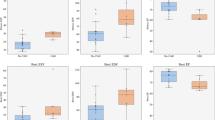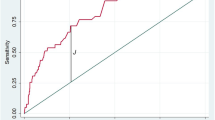Abstract
Objective
Percutaneous transluminal coronary angioplasty is a well-established therapeutic method in selected patients with coronary artery disease. The aim of this study was to assess the incremental prognostic value of technetium-99m (99mTc)-tetrofosmin myocardial gated-single- photon emission computed tomography (SPECT) in asymptomatic patients after coronary artery stenting.
Methods
A total of 246 consecutive patients (aged 55.5 ± 8.2 years, 182 men) participated in the study with a median follow-up of 9.5 years (interquartile ra 5.8–10.5 years). All patients underwent exercise gated-SPECT myocardial imaging within 5–7 months. Myocardial scintigrams were performed using 99mTctetrofosmin, and were evaluated calculating the summed stress score (SSS), summed rest score (SRS), and summed difference score (SDS) indexes. Cardiovascular death and non-fatal myocardial infarction were considered as hard cardiac events, and late revascularization (>3 months after myocardial SPECT) procedures as soft events. Receiver-operating characteristic (ROC) analysis was used to test the prognostic ability of SSS and SDS for cardiac events. Cox proportional hazards models were used to evaluate the incremental value of SPECT variables.
Results
Cardiac death occurred in 12 (4.9%) patients and non-fatal myocardial infarction in 20 (8.1%) patients. In addition, 60 (24.4%) patients underwent a late revascularization procedure. Using ROC analysis the optimal cut-offs of SSS (AUC = 0.94; 95% CI 0.92–0.97) and SDS (AUC = 0. 76; 95% CI 0.70–0.82) for the prediction of cardiac events were 10 and 1.7, respectively. Multiple Cox regression analyses revealed that SSS > 10 (HR = 24.2; 95% CI 7.44–78.79) and SDS > 1.7 (HR = 2.72; 95% CI 1.23–6.00) provided incremental prognostic value over clinical and exercise test data for the composite end points of any cardiac event.
Conclusions
99mTc-tetrofosmin myocardial gated- SPECT, performed 6 months post-percutaneous coronary intervention (PCI), provides incremental prognostic information for the prediction of cardiac events in asymptomatic patients after PCI.
Similar content being viewed by others
References
Serruys PW, Luijten HE, Beatt KJ, Geuskens R, de Feyter PJ, van den Brand M, et al. Incidence of restenosis after successful coronary angioplasty: a time-related phenomenon. A quantitative angiographic study in 342 consecutive patients at 1, 2, 3, and 4 months. Circulation 1988;77:361–371.
Califf RM, Fortin DF, Frid DJ, Harlan WR, Ohman EM, Bengtson JR, et al. Restenosis after coronary angioplasty: an overview. J Am Coll Cardiol 1991;17:2B–13B.
Gruentzig AR, King SB, Schlumpf M, Siegenthaler W. Longterm follow-up after percutaneous transluminal coronary angioplasty: the early Zurich experience. N Engl J Med 1987;316;1127–132.
Goy JJ, Eeckhout E. Intracoronary stenting. Lancet 1998;351:1943–1949.
Serruys P, de Jaegere P, Kiemeneij F, Macaya C, Rutsch W, Heyndrickx G, et al. A comparison of balloon-expandable-stent implantation with balloon angioplasty in patients with coronary artery disease. Benestent Study Group. N Engl J Med 1994;331:489–495.
Kastrati A, Schömig A, Elezi S, Dirschinger J, Mehilli J, Schühlen H, et al. Prognostic value of the modified American College of Cardiology/American Heart Association stenosis morphology classification for long-term angiographic and clinical outcome after coronary stent placement. Circulation 1999;100:1285–1290.
De Jaegere PP, Eefting FD, Popma JJ, Serruys PW. Clinical trials on intracoronary stenting. Semin Interv Cardiol 1996;1:233–245.
Fischman DL, Leon MB, Baim DS, Schatz RA, Savage MP, Penn I, et al. A randomized comparison of coronary-stent placement and balloon angioplasty in the treatment of coronary artery disease. Stent Restenosis Study Investigators. N Engl J Med 1994;331:496–501.
Giedd KN, Bergmann SR. Myocardial perfusion imaging following percutaneous coronary intervention. The importance of restenosis, disease progression, and directed reintervention. J Am Coll Cardiol 2004;43:328–336.
Adams GL, Ambati SR, Adams JM, Borges-Neto S. Role of nuclear imaging after coronary revascularization. J Nucl Cardiol 2006;13:163–169.
Hecht HS, Shaw RE, Bruce TR, Ryan C, Stertzer SH, Myler RK. Usefulness of tomographic thallium-201 imaging for detection of restenosis after percutaneous transluminal coronary angioplasty. Am J Cardiol 1990;66:1314–1318.
Hecht HS, Shaw RE, Chin HL, Ryan C, Stertzer SH, Myler RK. Silent ischemia after coronary angioplasty: evaluation of restenosis and extent of ischemia in asymptomatic patients by tomographic thallium-201 exercise imaging and comparison with symptomatic patients. J Am Coll Cardiol 1991;17:670–677.
Marie PY, Danchin N, Karcher G, Grentzinger A, Juilliere Y, Olivier P, et al. Usefulness of exercise SPECT-thallium to detect asymptomatic restenosis in patients who had angina before coronary angioplasty. Am Heart J 1993;126:571–577.
Milavetz JJ, Miller TD, Hodge DO, Holmes DR, Gibbons RJ. Accuracy of single-photon emission tomography myocardial perfusion imaging in patients with stents in native coronary arteries. Am J Cardiol 1998;82:857–861.
Kosa I, Blasini R, Schneider-Eicke J, Neumann FJ, Matsunari I, Neverve J, et al. Myocardial perfusion scintigraphy to evaluate patients after coronary stent implantation. J Nucl Med 1998;39:1307–1311.
Milan E, Zoccarato O, Terzi A, Ettori F, Leonzi O, Nicoli L, et al. Technetium-99m-sestamibi SPECT to detect restenosis after successful percutaneous coronary angioplasty. J Nucl Med 1996;37:1300–1305.
Georgoulias P, Demakopoulos N, Kontos A, Xaplanteris P, Thomadakis K, Mortzos G, et al. Tc-99m tetrofosmin myocardial perfusion imaging before and six months after percutaneous transluminal coronary angioplasty. Clin Nucl Med 1998;23:678–682.
Zellweger MJ, Weinbacher M, Zutter AW, Jeger RV, Mueller-Brand J, Kaiser C, et al. Long-term outcome of patients with silent versus symptomatic ischemia six months after percutaneous coronary intervention and stenting. J Am Coll Cardiol 2003;42:33–40.
Cottin Y, Rezaizadeh K, Touzery C, Barillot I, Zeller M, Prevot S, et al. Long-term prognostic value of 201Tl single-photon emission computed tomographic myocardial perfusion imaging after coronary stenting. Am Heart J 2001;141:999–1006.
Ho KT, Miller TD, Holmes DR, Hodge DO, Gibbons RJ. Long-term prognostic value of Duke treadmill score and exercise thallium-201 imaging performed one to three years after percutaneous transluminal coronary angioplasty. Am J Cardiol 1999;84:1323–1327.
Kaminek M, Myslivecek M, Skvarilova M, Husak V, Koranda P, Lang O. Prognostic value of myocardial perfusion tomographic imaging in patients after percutaneous transluminal coronary angioplasty. Clin Nucl Med 2000;25:775–778.
Acampa W, Petretta M, Florimonte L, Mattera A, Cuocolo A. Prognostic value of exercise cardiac tomography performed late after percutaneous coronary intervention in symptomatic and symptom-free patients. Am J Cardiol 2003;91:259–263.
Galassi AR, Grasso C, Azzarelli S, Ussia G, Moshiri S, Tamburino C. Usefulness of exercise myocardial scintigraphy in multivessel coronary disease after incomplete revascularization with coronary stenting. Am J Cardiol 2006;97:207–215.
Solodky A, Assali AR, Mats I, Ben-Gal T, Kornowski R, Battler A, et al. Prognostic value of myocardial perfusion imaging in symptomatic and asymptomatic patients after percutaneous coronary intervention. Cardiology 2007;107:38–43
Zhang X, Liu X, He ZX, Shi R, Yang M, Gao R, et al. Long-term prognostic value of exercise 99mTc-MIBI SPET myocardial perfusion imaging in patients after percutaneous coronary intervention. Eur J Nucl Med Mol Imaging 2004;31:655–662.
Rajagopal V, Gurm HS, Brunken RC, Pothier CE, Bhatt DL, Lauer MS. Prediction of death or myocardial infarction by exercise single photon emission computed tomography perfusion scintigraphy in patients who have had recent coronary artery stenting. Am Heart J 2005;149:534–540.
Coster CD, Quan H, Finlayson A, Gao M, Halfon P, Humphries K, et al. Identifying priorities in methodological research using ICD-9-CM and ICD-10 administrative data: report from an international consortium. BMC Health Services Research 2006;6:77–82.
Pitsavos CH, Chrysohoou C, Panagiotakos DB, Kokkinos P, Skoumas J, Papaioannou I, et al. Exercise capacity and heart rate recovery as predictors of coronary heart disease events, in patients with heterozygous familial hypercholesterolemia. Atherosclerosis 2004;173:347–352.
Fletcher GF, Balady G, Froelicher VF, Hartley LH, Haskell WL, Pollock ML. Exercise standards: a statement for healthcare professionals from the American Heart Association Writing Group. Circulation 1995;91:580–615.
Lauer MS, Francis GS, Okin PM, Pashkow FJ, Snader CE, Marwick TH. Impaired chronotropic response to exercise stress testing as a predictor of mortality. JAMA 1999;281:524–529.
Georgoulias P, Orfanakis A, Demakopoulos N, Xaplanteris P, Mortzos G, Vardas P, et al. Abnormal heart rate recovery immediately after treadmill testing: correlation with clinical, exercise testing, and myocardial perfusion parameters. J Nucl Cardiol 2003;10:498–505.
Rahimi K, Thomas A, Adam M, Hayerizadeh BF, Schuler G, Secknus MA. Implications of exercise test modality on modern prognostic markers in patients with known or suspected coronary artery disease: Treadmill versus bicycle. Eur J Cardiovasc Prev Rehabil 2006;13:45–50.
Beller GA, Zaret BL. Contributions of nuclear cardiology to diagnosis and prognosis of patients with coronary artery disease. Circulation 2000;101:1465–1478.
Kapur A, Latus KA, Davies G, Dhawan RT, Eastick S, Jarritt PH, et al. A comparison of three radionuclide myocardial perfusion tracers in clinical practice: the ROBUST study. Eur J Nucl Med 2002;29:1608–1616.
Nakajima K, Kusuoka H, Nishimura S, Yamashina A, Nishimura T. Normal limits of ejection fraction and volumes determined by gated SPECT in clinically normal patients without cardiac events: a study based on the J-ACCESS database. Eur J Nucl Med Mol Imaging 2007;34:1088–1096.
Cerqueira MD, Weissman NJ, Dilsizian V, Jacobs AK, Kaul S, Laskey WK, et al. Standardized myocardial segmentation and nomenclature for tomographic imaging of the heart: a statement for healthcare professionals from the Cardiac Imaging Committee of the Council on Clinical Cardiology of the American Heart Association. J Nucl Med 2002;9:240–245.
Cox DR. Regression models and life tables. J R Stat Soc B 1972;34:187–202.
Schinkel AFL, Elhendy A, van Domburg RT, Bax JJ, Vourvouni EC, Bountioukos M. Incremental value of exercise technetium-99m tetrofosmin myocardial perfusion singlephoton emission computed tomography for the prediction of cardiac events. Am J Cardiol 2003;91:408–411.
Sridhara BS, Braat S, Rigo P, Itti R, Cload P, Lahiri A. Comparison of myocardial perfusion imaging with technetium- 99m tetrofosmin versus thallium-201 in coronary artery disease. Am J Cardiol 1993;72:1015–1019.
Georgoulias P, Demakopoulos N, Kontos A, Xaplanteris P, Tomadakis K, Mortzos G, et al. 99mTc-tetrofosmin myocardial perfusion imaging: a comparison with coronary angiography. Nuklearmedizin 1996;35:153–155.
Elhendy A, Schinkel AF, van Domburg RT, Bax JJ, Valkema R, Poldermans D. Risk stratification of patients after myocardial revascularization by stress Tc-99m tetrofosmin myocardial perfusion tomography. J Nucl Cardiol 2003;10:615–622.
Germano G, Berman DS. Regional and global ventricular function and volumes from single-photon emission computed tomography perfusion imaging. In: Zarret BL, Beller GA III, editors. Clinical nuclear cardiology. state of the art and future directions. Philadelphia: Elsevier Mosby; 2005. p. 189–202.
Author information
Authors and Affiliations
Corresponding author
Rights and permissions
About this article
Cite this article
Georgoulias, P., Tzavara, C., Demakopoulos, N. et al. Incremental prognostic value of 99mTc-tetrofosmin myocardial SPECT after percutaneous coronary intervention. Ann Nucl Med 22, 899–909 (2008). https://doi.org/10.1007/s12149-008-0191-7
Received:
Accepted:
Published:
Issue Date:
DOI: https://doi.org/10.1007/s12149-008-0191-7




